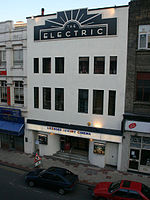Ringway Centre
Buildings and structures completed in 1962Buildings and structures in Birmingham, West MidlandsThe Twentieth Century Society Risk List

Ringway Centre is a Grade B locally listed building located on Smallbrook Queensway in the city centre of Birmingham, England. The six-storey, 230 metres (750 ft) long building was designed by architect James Roberts as part of the Inner Ring Road scheme in the 1950s and is notable for its gentle sweeping curved frontal elevation.Completed in 1962, the Ringway Centre was the first part of the Inner Ring Road scheme to be completed, and the only part with street-level shops and footways. The building currently provides office space on its upper floors and commercial space at street level.
Excerpt from the Wikipedia article Ringway Centre (License: CC BY-SA 3.0, Authors, Images).Ringway Centre
Smallbrook Queensway, Birmingham Digbeth
Geographical coordinates (GPS) Address Phone number Website Nearby Places Show on map
Geographical coordinates (GPS)
| Latitude | Longitude |
|---|---|
| N 52.475566 ° | E -1.898081 ° |
Address
Snobs (Snobs Birmingham)
Smallbrook Queensway 51
B5 4HX Birmingham, Digbeth
England, United Kingdom
Open on Google Maps








